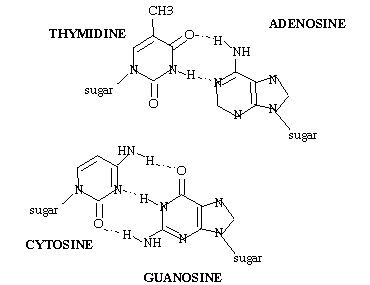
| MadSci Network: Molecular Biology |
| MadSci Network: Molecular Biology |
THESE ARE THE BASE PAIRS IN DOUBLE STRANDED (DNA dsDNA).
The anti-parallel strands allow for the formation of hydrogen bonds as illustrated in the figure. If the strands were not antiparallel these non-symetrical hydrogen bonding interactions would not be possible. It is important that CG interactions have three H- bonds, and AT have two H-bonds, to keep these parings specific.

The anitparallel organization also means that both strands can be made the same way, using the same isomers, and using the same enzymes. The dsDNA molecule is quite robust and stable in the correct conditions. For example, careful purification of DNA only takes about one hour, and we keep the DNA disolved in Tris buffer (pH 7.5-8.5) with some EDTA to trap Mg++ ions. (DNAase enzymes that cut up DNA need Mg++ for activity, so EDTA keeps them inactive). In such a buffer, the DNA (say a plasmid from E. coli) is stable for years in a common refrigerator, or even at room temperature in the dark.
As you know DNA can even be isolated in quite large lengths from biological remains that are thousands of years old. This particular double helical structure with a high density of H-bonds per unit length is a very robust and stable structure for storage of genetic sequence, yet it can be unravelled as required for replication of DNA strands, and the transcription of mRNA.
Kenneth P. Mitton, PhD
kpmitton@umich.edu
734-936-8370
http://141.214.184.151/
mitton.html
Editor, Eye Research Network
http://141.214.184.151/ern
Try the links in the MadSci Library for more information on Molecular Biology.